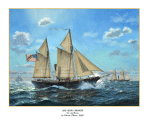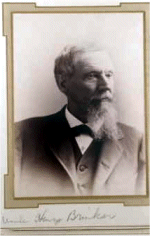
098669701 |
307k |
Maritime artist Patrick O'Brien painting (2020) of USS Henry Brinker based on available data researched by a group of naval
historians including James Delgado in 2020 to determine what Henry Brinker looked like. As a result of that analysis the this portrait of Brinker
was produced.
No drawings or photographs of the Henry Brinker were known to survive. This is a common problem. As Richard Latture, editor of Naval History magazine at the USNI said,
“It’s going to be hard to find a photo of a ship so small.” And, as Peter McCracken of ShipIndex.org. noted, “Finding images of early vessels is really tough work --
there just haven’t been that many early images that have been published or reprinted.” So we are left with informed speculation and educated guessing. To determine
what the Henry Brinker may have looked like I turned to Patrick O’Brien for advice. He researched other vessels built at the same time and in the same place for about
the same purpose. He also consulted with Richard Latture, Deirdre E. O’Regan, Peter McCracken and James Delgado on what the Henry Brinker might have looked like.
James Delgado of SEARCH advised Patrick that, “Most screw-steamers of the time were wooden-hulled. Usually they’d call out if it was an “iron screw-steamer,” so let’s
assume that when Henry Brinker built his eponymous steamer in Brooklyn, it was wooden. It’d likely carry the usual two-masted steamer rig of the time, which was a
brigantine. At sea, there were times those were down-rigged. It would be single-stacked. The stack would be between the masts, as engines were generally midships, but
occasionally slightly aft.” Delgado provided an image of USS Monticello, which was a 180-foot wooden screw steamer built as a merchant vessel in 1859 and used in the
Civil War as a potential model. He believed that this image, scaled down, might approximate what Henry Brinker likely looked like. Brinker is interesting because it
truly represents that rush for ships the Navy engaged in to enforce the blockade.” Patrick O’Brien believed that USS Fuschia might be a better model. Like Brinker she
was built in Brooklyn in a private shipyard. According to an 1895 edition of the Rochester Post Express, Henry Brinker engaged in ship building in 1855 “and in 1859
built the steamer Henry Brinker, which he afterwards sold to the United States government….” Other sources say the ship was built in 1861. Fuschia had been originally
intended for the Chinese government, but like Brinker, she was bought by the Union Navy. She was a bit longer than Brinker (98.3-feet versus 82-feet for Brinker), and
a bit narrower, with a beam of 21.9-feet versus Brinker’s 26.7-feet. Her main armament was somewhat similar. Fuschia had a 30-pound rifle and one 24-pound howitzer.
Henry Brinker had one 30-pounder and two 12-pounders. For Patrick O’Brien, this meant that she probably had one big gun forward and two smaller guns astern. The bow
gun was probably a 4.2-inch 30-pound Naval Parrott rifle. It was probably mounted on the centerline on a swivel to allow it to fire to port and starboard. There were
probably wide drop-down ports cut into the bulwarks on the bow quarters to allow the gun to fire at various angles. He suspected the 12-pounders were mounted in the
stern quarters, port and starboard, on carriages, not swivels, so there would be two gunports cut into the bulwarks on each side: a wide one forward, and a square one
aft. |
Submitted by James Bruns |

